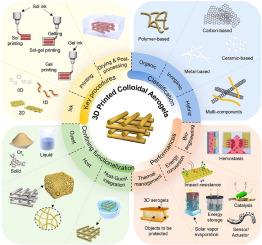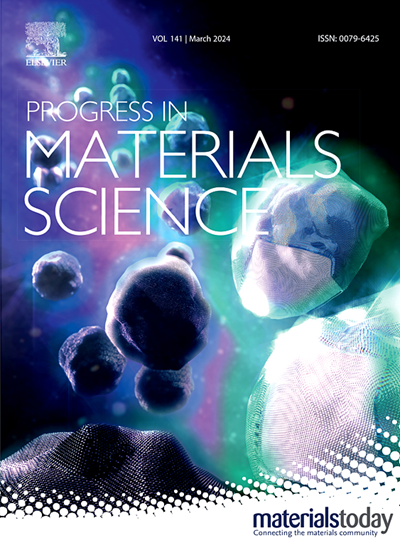3D打印胶体气凝胶:原理,过程,性能和观点
IF 40
1区 材料科学
Q1 MATERIALS SCIENCE, MULTIDISCIPLINARY
引用次数: 0
摘要
气凝胶是一种关键的多孔纳米材料,由于其庞大的体系和独特的性能,涉及但不限于材料科学、溶胶-凝胶化学、物理和生物学等多个学科。3D打印技术进一步赋予气凝胶定制的宏观几何形状、设计的分层结构和集成的复杂部件,这意味着与性能和应用密切相关的可控结构很容易实现。然而,尽管迄今为止已经取得了丰富的成果,但对3D打印气凝胶的系统概述仍处于早期阶段。本文首次从胶体科学的角度对“3D打印胶体气凝胶及其研究进展”这一主题进行了深入的总结,包括其发展的时间线、关键步骤、打印策略、分类、制备工艺、制备工艺等。有限的功能化,迷人的特性和新兴的应用,以及当前的挑战和未来的机遇。特别地,详细介绍了打印过程中的热力学/动力学,溶胶/溶胶-凝胶/凝胶打印策略和限制功能化。因此,可以预期,这一综述可能会为3D打印胶体气凝胶的发展注入新的活力。本文章由计算机程序翻译,如有差异,请以英文原文为准。


3D printed colloidal aerogels: Principle, process, performance, and perspective
Aerogels is a kind of pivotal porous nano-materials mushroomed in multiple disciplines, involving but not limited to material science, sol–gel chemistry, physics and biology, due to their tremendous systems and exotic properties. 3D printing techniques further endow aerogels with customized macroscopic geometries, designed hierarchical structures, and integrated complex components, which means that the controllable structure closely associated with performance and application is easy to achieve. However, although abundant achievements have been made so far, systemic overview on 3D printed aerogels is still on its early stage. In this review, a term of “colloidal aerogels” is emphasized to describe those aerogels prepared from nanoscale building blocks as the starting materials by using dispersion-stabilization-destabilization processes, and the theme of “3D printed colloidal aerogels together with their state-of-art progress” is summarized in depth from a colloidal science perspective for the first time, including the developed timeline, key procedures, printing strategies, the classification, the confining functionalization, fascinating properties and emerging applications, as well as current challenges and future opportunities. In especial, the thermodynamics/kinetics during printing, sol/sol–gel/gel printing strategies, and confining functionalization are elaborately introduced. Therefore, it can be expected that this review might breathe new life into the development of 3D printed colloidal aerogels.
求助全文
通过发布文献求助,成功后即可免费获取论文全文。
去求助
来源期刊

Progress in Materials Science
工程技术-材料科学:综合
CiteScore
59.60
自引率
0.80%
发文量
101
审稿时长
11.4 months
期刊介绍:
Progress in Materials Science is a journal that publishes authoritative and critical reviews of recent advances in the science of materials. The focus of the journal is on the fundamental aspects of materials science, particularly those concerning microstructure and nanostructure and their relationship to properties. Emphasis is also placed on the thermodynamics, kinetics, mechanisms, and modeling of processes within materials, as well as the understanding of material properties in engineering and other applications.
The journal welcomes reviews from authors who are active leaders in the field of materials science and have a strong scientific track record. Materials of interest include metallic, ceramic, polymeric, biological, medical, and composite materials in all forms.
Manuscripts submitted to Progress in Materials Science are generally longer than those found in other research journals. While the focus is on invited reviews, interested authors may submit a proposal for consideration. Non-invited manuscripts are required to be preceded by the submission of a proposal. Authors publishing in Progress in Materials Science have the option to publish their research via subscription or open access. Open access publication requires the author or research funder to meet a publication fee (APC).
Abstracting and indexing services for Progress in Materials Science include Current Contents, Science Citation Index Expanded, Materials Science Citation Index, Chemical Abstracts, Engineering Index, INSPEC, and Scopus.
 求助内容:
求助内容: 应助结果提醒方式:
应助结果提醒方式:


